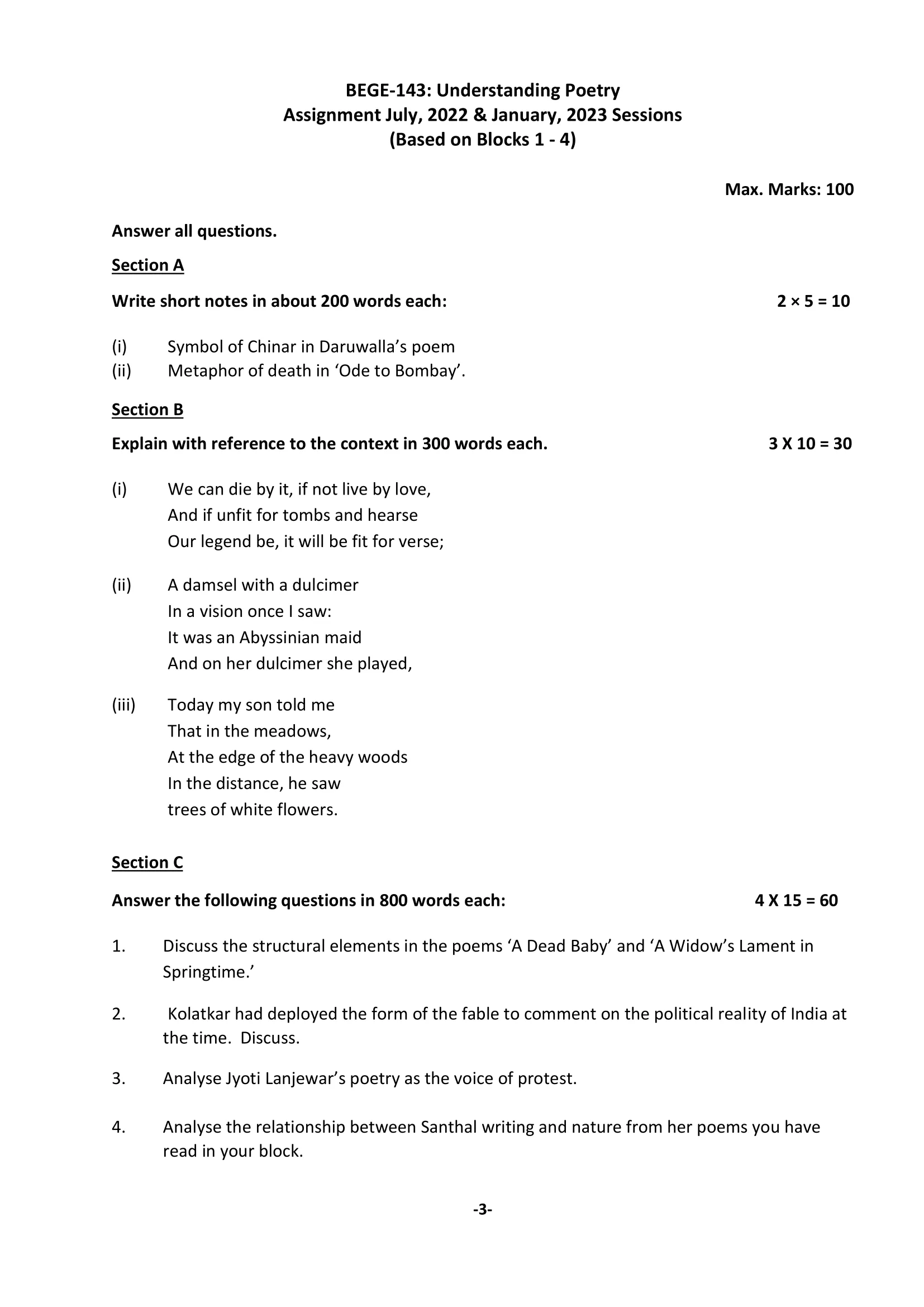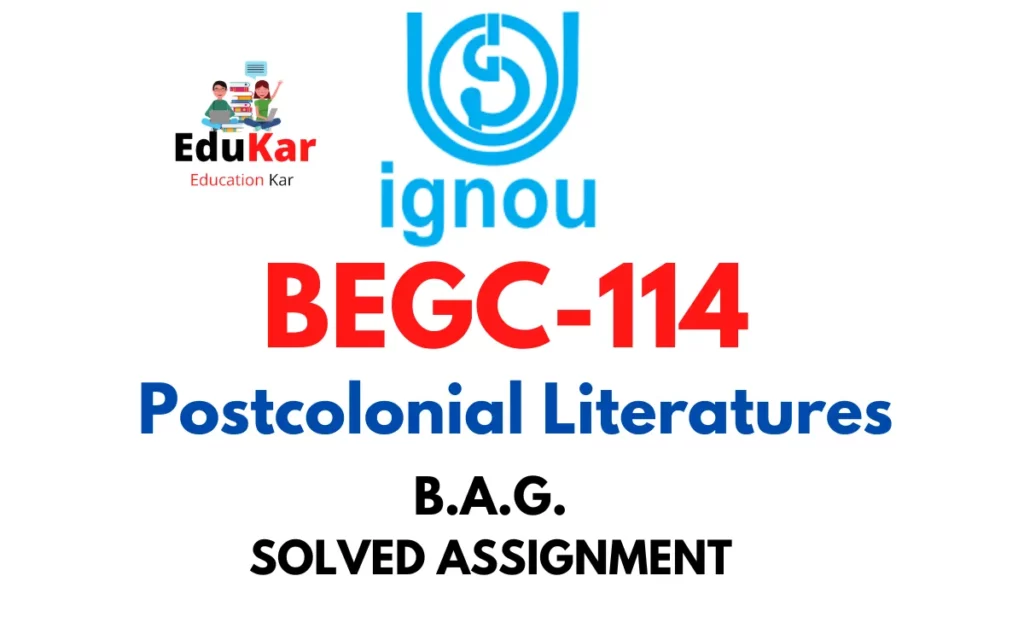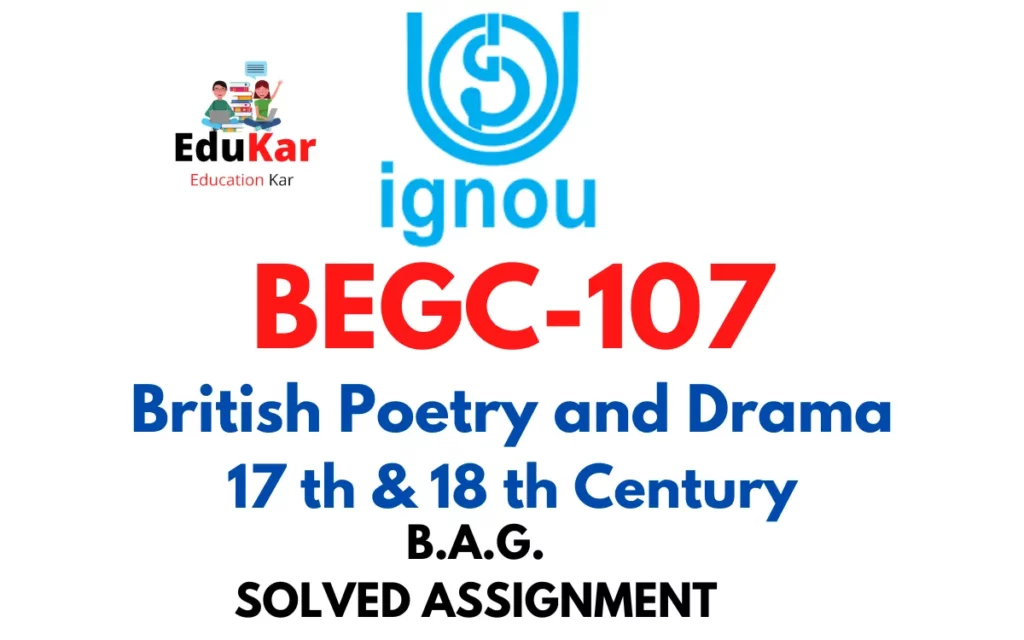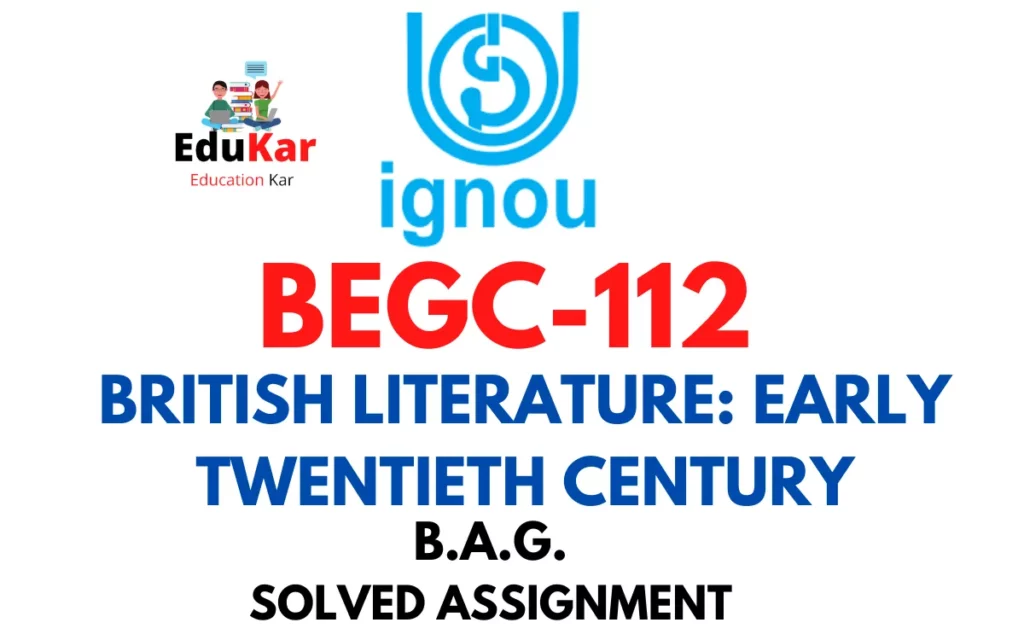Contents
- 1 Section A
- 2 Write short notes in about 200 words each: 2×5=10
- 3 (i) Symbol of Chinar in Daruwalla’s poem.
- 4 (ii) Metaphor of death in ‘Ode to Bombay’.
- 5 Section B
- 6 Explain with reference to the context in 300 words each. 3X10=30
- 7 Section C
- 8 Answer the following questions in 800 words each: 4X15=60
- 9 1.Discuss the structural elements in the poems ‘A Dead Baby’ and ‘A Widow’s Lament in Springtime.’
- 10 2. Kolatkar had deployed the form of the fable to comment on the political reality of India at the time. Discuss.
- 11 3. Analyse Jyoti Lanjewar’s poetry as the voice of protest.
- 12 4. Analyse the relationship between Santhal writing and nature from her poems you have read in your block.

| Title | BEGE-143: Understanding Poetry IGNOU BAG Solved Assignment 2022-2023 |
| University | IGNOU |
| Degree | Bachelor Degree Programme |
| Course Code | BEGE-143 |
| Course Name | Understanding Poetry |
| Programme Name | Bachelor of Arts (General) |
| Programme Code | BAG |
| Total Marks | 100 |
| Year | 2022-2023 |
| Language | English |
| Assignment Code | BANS 183/ASST/TMA |
| Last Date for Submission of Assignment: | For June Examination: 31st April For December Examination: 30th September |

Section A
Write short notes in about 200 words each: 2×5=10
(i) Symbol of Chinar in Daruwalla’s poem.
Ans: The Chinar is a symbol that appears in many of the poems written by the Indian poet, Keki N. Daruwalla. It is a tree that is native to the Kashmir Valley and is known for its large, spreading canopy and distinctive, heart-shaped leaves. In Daruwalla’s poems, the Chinar tree serves as a symbol of the resilience of the Kashmiri people and the beauty of the region. The tree is often described as standing tall and proud, even in the face of violence and destruction.
The Chinar also symbolizes the cycle of life and death, with its leaves falling to the ground each autumn, only to be replaced by new growth in the spring. This metaphor reflects the ongoing cycle of conflict and peace in the region, and the resilience of the Kashmiri people in the face of adversity.
In Daruwalla’s poems, the Chinar is also often associated with memory and nostalgia. The tree serves as a reminder of the rich cultural heritage of the region and the importance of preserving it for future generations. It is a symbol of the connection between the people of Kashmir and the land they call home, a connection that is unbreakable, even in the face of the greatest hardships.
(ii) Metaphor of death in ‘Ode to Bombay’.
Ans: The metaphor of death is a prominent theme in the poem “Ode to Bombay” by Keki N. Daruwalla. The poem is a nostalgic tribute to the city of Bombay, which is now known as Mumbai. The poet reflects on the changes that have taken place in the city over the years and mourns the loss of its former beauty and character.
Throughout the poem, death is used as a metaphor to describe the decline and decay of the city. The poet writes of the “decaying buildings” and the “fading lights” of Bombay, using these images to suggest the slow death of the city’s once-vibrant spirit. The metaphor of death is also used to describe the passing of time, with the poet acknowledging that the city will never be the same as it was in its prime.
In addition to the metaphor of death, the poem also employs the imagery of a funeral procession to describe the decline of the city. The poet writes of “black umbrellas” and “somber faces” moving through the streets, painting a vivid picture of the mournful atmosphere that permeates the city. The use of this metaphor reinforces the idea that the city of Bombay has died, and that its people are left to mourn its passing.
Finally, the poem also uses the metaphor of death to suggest the impermanence of all things. The poet acknowledges that everything, including cities, eventually dies and passes into memory, and that the only thing that remains is the legacy it leaves behind. This idea is reflected in the final lines of the poem, in which the poet writes that “All that remains is a memory.”
Section B
Explain with reference to the context in 300 words each. 3X10=30
(i) We can die by it, if not live by love,
And if unfit for tombs and hearse
Our legend be, it will be fit for verse;
Ans: This quote is referencing the idea that love can be both life-giving and life-taking. The speaker suggests that if one does not live by love, it can lead to death. Furthermore, even if the person’s life is not fit for a tomb or a traditional funeral procession, it can still be celebrated in verse.
The phrase “if not live by love” implies that love is a necessary component of life, and if it is lacking, it can lead to death. On the other hand, if one lives fully by love, it can sustain and enrich life.
The mention of tombs and hearse highlights the idea that a person’s life can be commemorated after death through physical memorials. However, the speaker suggests that even if a person’s life is not deemed significant enough for a traditional funeral, it can still be celebrated in verse, which highlights the power of art and literature to immortalize individuals and their experiences.
(ii) A damsel with a dulcimer
In a vision once I saw:
It was an Abyssinian maid
And on her dulcimer she played,
Ans: These lines are from the poem “Kubla Khan” by Samuel Taylor Coleridge. The poem describes a dream-like vision of a beautiful young woman playing a dulcimer, a type of stringed musical instrument. The poem is considered one of the best examples of Romantic literature, which emphasized emotion and individualism, as well as the power of the imagination and nature.
In the poem, the sight of the “Abyssinian maid” playing her dulcimer creates a dream-like, otherworldly atmosphere, showcasing the imagination’s power to transport the reader to another place and time. The use of the word “damsel” adds to the fairy-tale like quality of the vision, further emphasizing the fantastical elements of the poem.
The dulcimer, with its beautiful and melancholic sound, represents the power of music to evoke emotion and stir the imagination. The image of the “Abyssinian maid” playing the dulcimer creates a powerful contrast between the exotic, far-off location of Abyssinia and the dream-like, imaginative world of the poet.
(iii) Today my son told me
That in the meadows,
At the edge of the heavy woods
In the distance, he saw
trees of white flowers.
Ans: The poem “Today my son told me” is a short, simple, and poignant work that captures the essence of the relationship between a parent and child. Through the words of the narrator, we are transported to a place of wonder and awe as the son shares his experience of seeing trees with white flowers in the meadows at the edge of the heavy woods.
In the context of the poem, the narrator is a parent who is listening to the tale of their son, and the wonder and awe that he experienced. This simple act of listening and paying attention to their child is a significant aspect of the parent-child relationship, and highlights the importance of open communication and nurturing the emotional connection between a parent and their child.
The description of the trees with white flowers in the meadows at the edge of the heavy woods serves as a metaphor for the beauty and purity of innocence. The image of the white flowers represents the innocence of childhood and the wonder that comes with it. This innocence is juxtaposed against the “heavy woods,” which represents the challenges and obstacles that life presents.
The poem highlights the transformative power of nature and the way in which it can evoke deep emotions and connections in people. The description of the trees and the flowers serves as a reminder of the beauty and simplicity of life and the importance of taking the time to appreciate it.
Section C
Answer the following questions in 800 words each: 4X15=60
1.Discuss the structural elements in the poems ‘A Dead Baby’ and ‘A Widow’s Lament in Springtime.’
Ans: The poems “A Dead Baby” and “A Widow’s Lament in Springtime” by Keki N. Daruwalla are powerful expressions of grief and loss. Both poems employ a range of structural elements, including imagery, metaphor, and form, to convey their themes of death and mourning.
In “A Dead Baby,” Daruwalla uses imagery to paint a vivid picture of the death of a child. The poem begins with a description of the baby’s small, lifeless body, and this image serves as the central metaphor for the loss that the speaker is mourning. Throughout the poem, the speaker reflects on the tragedy of the baby’s death, using imagery to convey their sadness and grief. For example, the speaker describes the baby as being “wrapped in a shroud,” an image that suggests the finality of death and the hopelessness of the situation.
In addition to its use of imagery, “A Dead Baby” also employs the metaphor of a journey to describe the process of mourning. The speaker writes that the baby’s death is a journey “to the unknown,” and that the baby is now “travelling to a place that [the speaker] will never reach.” This metaphor highlights the speaker’s sense of distance and separation from the baby, and the idea that death is a journey that we all must take.
The poem “A Widow’s Lament in Springtime” also employs a range of structural elements to convey its themes of loss and grief. The poem is structured as a lament, a form of poetry that is often used to express sorrow and mourning. The speaker of the poem is a widow, who is mourning the loss of her husband and the end of their relationship. Like “A Dead Baby,” “A Widow’s Lament in Springtime” uses imagery to create a powerful picture of the speaker’s grief. For example, the speaker writes that “The flowers bloom and the birds sing / But I am still a prisoner of my mourning.” This image conveys the idea that the speaker is trapped in her grief, even as the world around her continues to move forward.
In addition to its use of imagery, “A Widow’s Lament in Springtime” also employs metaphor to express the speaker’s sense of loss. For example, the speaker writes that “My husband’s absence is a wound that never heals,” a metaphor that highlights the idea that the loss of a loved one is a wound that never fully heals. This metaphor is particularly poignant in the context of the poem, as it is set in springtime, a time of renewal and rebirth. The idea that the speaker is stuck in her grief, even as the world around her is undergoing a transformation, reinforces the sense of loss and hopelessness that pervades the poem.
The form of both poems is also an important structural element, contributing to their overall impact. “A Dead Baby” is written in free verse, a form that allows the speaker to express their grief in a free-flowing, unstructured way. This form gives the speaker the freedom to explore the many different emotions associated with the death of a child, and to paint a vivid picture of the loss they are mourning. “A Widow’s Lament in Springtime” is also written in free verse, allowing the speaker to express their grief in an unstructured way. However, the poem also has a rhythmic quality, with its repeated use of end-stopped lines and its use of rhyme, contributing to its overall impact.
2. Kolatkar had deployed the form of the fable to comment on the political reality of India at the time. Discuss.
Ans: Arun Kolatkar, one of the most innovative poets in modern Indian literature, used the form of the fable to comment on the political reality of India at the time. A fable is a short narrative that uses animals or other non-human characters to comment on human behavior and moral values. Kolatkar’s fables are characterized by their simplicity, humor, and wit, and they serve as a means of critiquing the social and political conditions in India.
One of Kolatkar’s most famous fables is “The Crow and the Peacock,” which uses the interactions between two birds to comment on the relationship between India and England during the colonial period. The crow, who represents India, is depicted as a beggar, while the peacock, who represents England, is depicted as a proud and arrogant bird. The fable ends with the crow asking the peacock for some food, and the peacock refusing, saying that he is not obligated to help the crow. This fable serves as a commentary on the exploitative relationship between India and England, with the peacock symbolizing the arrogance and cruelty of the colonial rulers, and the crow representing the poverty and helplessness of the Indian people.
Another fable by Kolatkar, “The Jackal and the Drum,” uses the interactions between a jackal and a drum to comment on the political corruption in India. The jackal, who represents the corrupt politicians and bureaucrats, is depicted as a cunning and greedy animal, while the drum, who represents the voice of the people, is depicted as a simple and honest instrument. The fable ends with the jackal stealing the drum and hiding it in a cave, in order to silence the voice of the people. This fable serves as a commentary on the corrupt practices of Indian politicians and bureaucrats, who often use their power and influence to silence the voices of ordinary citizens.
In “The Tortoise and the Hare,” Kolatkar uses the interactions between a tortoise and a hare to comment on the relationship between India and the West. The hare, who represents the West, is depicted as a fast-paced and sophisticated animal, while the tortoise, who represents India, is depicted as slow and steady. The fable ends with the tortoise winning the race, demonstrating the persistence and determination of the Indian people. This fable serves as a commentary on the importance of perseverance and hard work in the face of adversity, and the ways in which India can overcome the challenges posed by the West.
In addition to these fables, Kolatkar also used other forms, such as the ghazal and the sonnet, to comment on the political and social conditions in India. For example, his ghazals often use humor and irony to critique the social and political realities of Indian society, while his sonnets use classical forms to comment on contemporary issues.
3. Analyse Jyoti Lanjewar’s poetry as the voice of protest.
Ans: Jyoti Lanjewar, a contemporary Indian poet, is known for her powerful voice of protest in her poetry. Born in a rural area in central India, Lanjewar has firsthand experience of the social and political inequalities that exist in Indian society. Her poetry reflects her deep concern for the marginalized and oppressed sections of society, and serves as a powerful voice of protest against the injustices they face.
Lanjewar’s poems are characterized by their honesty, directness, and emotional intensity. Her poems deal with a wide range of social and political issues, including poverty, oppression, discrimination, and the marginalization of women and Dalits (formerly known as “untouchables”). Through her poetry, Lanjewar gives a voice to the marginalized and oppressed, and highlights the injustices they face on a daily basis.
In her poem “The Silent Scream,” Lanjewar uses vivid imagery and strong language to comment on the exploitation and oppression of women. The poem depicts a woman’s silent scream, symbolizing the pain and suffering that women are forced to endure in a patriarchal society. The poem highlights the injustices faced by women, including domestic violence, discrimination in the workplace, and unequal pay. Through the use of vivid imagery and powerful language, Lanjewar gives voice to the silent scream of women, and brings attention to the ongoing struggle for women’s rights in India.
In another poem, “The Unseen Face,” Lanjewar comments on the invisibility and marginalization of Dalits in Indian society. The poem portrays the unseen face of the Dalit, symbolizing the way in which they are hidden from view and excluded from mainstream society. The poem highlights the discrimination and oppression that Dalits face, including violence, poverty, and exclusion from educational and economic opportunities. Through the use of powerful imagery and language, Lanjewar gives voice to the unseen face of the Dalit, and calls attention to the ongoing struggle for their rights and dignity.
Lanjewar’s poems also reflect her deep concern for the environment and her commitment to preserving the natural world. In her poem “The Dying Earth,” Lanjewar uses vivid imagery and strong language to comment on the destruction of the environment and the loss of biodiversity. The poem portrays the earth as a dying organism, symbolizing the ongoing decline of the planet due to human actions such as deforestation, pollution, and climate change. The poem highlights the urgent need for action to protect the environment and preserve the planet for future generations.
In addition to her poems, Lanjewar is also known for her activism and her commitment to social justice. She is involved in various social and political causes, and uses her poetry as a means of bringing attention to important issues and inspiring change. Her poetry serves as a powerful voice of protest, and is widely read and appreciated by people around the world.
4. Analyse the relationship between Santhal writing and nature from her poems you have read in your block.
Ans: The relationship between Santhal writing and nature is a complex and dynamic one, rooted in the culture, traditions, and beliefs of the Santhal people. This relationship can be seen throughout the poems written by Santhal authors, who often use nature as a metaphor for various themes and emotions. In this essay, we will examine the relationship between Santhal writing and nature by analyzing several of the poems written by Santhal authors.
One of the most notable aspects of the relationship between Santhal writing and nature is the way in which the authors use nature to reflect the emotional state of their characters. In many of the poems, nature serves as a backdrop against which the characters’ experiences are portrayed. For example, in the poem “The Forest,” the author uses the lush and dense forest as a metaphor for the character’s feelings of suffocation and entrapment. The dense trees, with their thick leaves and tangled branches, represent the obstacles and challenges that the character faces, and the inability to escape from their situation.
Another common theme in Santhal writing is the use of nature to reflect the relationship between human beings and the divine. In many poems, the beauty and majesty of nature is seen as a manifestation of the presence of a higher power. For example, in the poem “The Mountain,” the author uses the massive, towering mountain as a symbol of the divine. The mountain represents the unyielding and eternal power of the divine, and the character’s awe and reverence for it is a reflection of their deep spiritual connection to the natural world.
Santhal writers also use nature as a metaphor for the cycle of life and death. In many poems, the changing seasons, the growth and decay of plants and animals, and other natural cycles are used to reflect the characters’ experiences with birth, death, and rebirth. For example, in the poem “The River,” the author uses the river as a metaphor for the cycle of life and death. The river represents the flow of life, with its ebb and flow, and the character’s journey along its course represents the journey of life itself.
The relationship between Santhal writing and nature is also reflected in the use of imagery. Santhal authors often use vivid, evocative descriptions of the natural world to create a sense of place and to evoke emotions in the reader. For example, in the poem “The Forest,” the author describes the dense, tangled forest in great detail, using sensory descriptions of the trees, leaves, and other elements of the forest to create a rich and immersive experience for the reader. Similarly, in the poem “The Mountain,” the author describes the towering peak with words like “massive” and “eternal,” conveying a sense of awe and reverence for the natural world.
How to Download BEGE-143 Solved Assignment?
You can download it from the www.edukar.in, they have a big database for all the IGNOU solved assignments.
Is the BEGE-143 Solved Assignment Free?
Yes this is absolutely free to download the solved assignment from www.edukar.in
What is the last submission date for BEGE-143 Assignment?
For June Examination: 31st April, For December Examination: 30th October
















